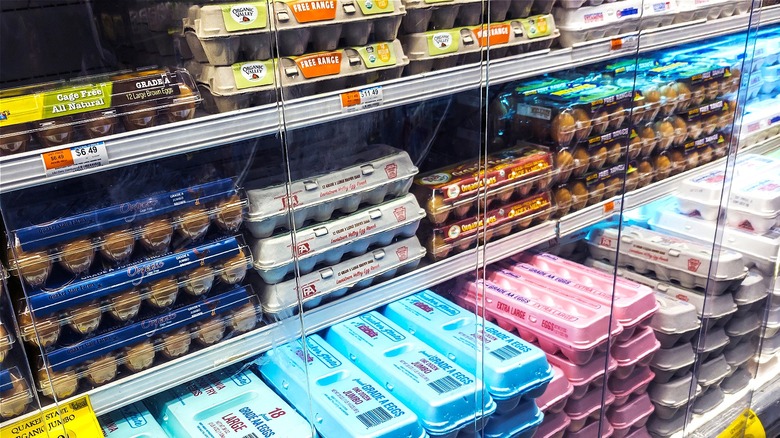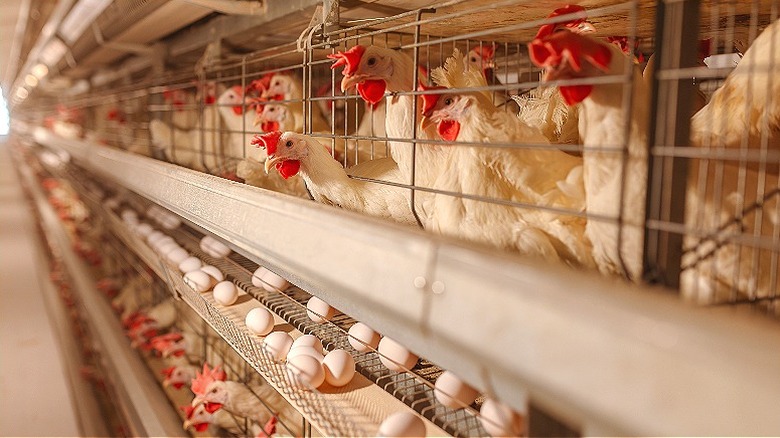Egg Prices Are Skyrocketing Again And Americans Have This To Blame For It
As you plan your weekly meal prep, NFL Sunday food spread, or even this year's Thanksgiving Day meal, you'll probably notice that egg prices have gone up (again). In fact, according to the latest data from the U.S. Bureau of Labor Statistics, the average price for a dozen Grade A large eggs in October 2024 was $3.37. While this price is slightly down from September, it is important to realize that it still represents a 30.4% increase from egg prices a year ago. Plus, certain states, like California, are facing even higher prices (with U.S. Department of Agriculture market data for the week of November 20 showing a dozen large eggs were being sold for $5.21).
While, at the national level, average egg prices haven't yet returned to their peak price of $4.82, which happened in January 2023, they have been on a generally upward trajectory for most of 2024, which can add even more expense to most consumers' already expensive grocery bill. According to data from the USDA, food prices increased 25% from 2019 to 2023 across the board (not to mention how much money Americans lose to uneaten food every year). This leaves more and more Americans struggling to buy the essentials and is probably a significant factor in the country's ever-rising credit card debt. However, while post-pandemic supply chain issues and inflation have been the primary factors behind the increase in most food prices, eggs and poultry products are actually experiencing price complications from another culprit altogether: H5N1.
How H5N1 affects egg prices
You might be surprised to hear that inflation isn't the biggest culprit when it comes to egg prices. Instead, a strain of bird flu known as H5N1 has been significantly impacting egg production across the country. This is because this strain of bird flu is not only highly transmissible but it is also fatal, leading to the deaths of millions of egg-producing birds. According to the U.S. Centers for Disease Control and Prevention, as of November 20, 2024 an astonishing 108,412,219 birds (used for poultry) have been affected by this flu.
What has made managing H5N1 outbreaks so especially difficult is that the flu is largely spread by wild birds. This has led to 1,219 different outbreaks across 49 states since the flu was first detected in January 2022. It is also worth mentioning that before the 2022 detection, the CDC had not detected this bird flu since 2016. Even more troubling is that there have now been several hundred confirmed cases of H5N1 in dairy cattle across 15 states (as of November 2024) and 52 confirmed human cases.
It's worth noting that, unlike with birds, dairy cows face a low mortality rate when it comes to H5N1 infections whereas 52% of people from around the world who have experienced H5N1 infections have died, according to research from the CDC. As of now, there has been no progress on sequencing the strain in order to come up with a potential vaccine. This means there's a high potential that this bird flu will continue into the future.
Other consumer impacts
While the shortage of available birds (and therefore eggs) has contributed to the rise in egg prices across the country, it's also affecting other less obvious areas. Perhaps the most significant thing for consumers to know is that they are ultimately paying for these bird flu outbreaks, and subsequent culls, and not just at the grocery store. For those who might not know, the USDA operates a compensation program wherein they pay poultry producers the cost of their lost product (in this case turkeys, chickens, and egg-laying hens) when the animals die or are culled as a result of H5N1 detection procedures.
According to The New York Times, this compensation amounted to more than half a billion dollars in 2023. Some of the largest receivers of these compensation packages include household names like Jennie-O Turkey and Tyson Foods. These corporations not only report billions of dollars worth of profits, but are essentially incentivized (due to the USDA's compensation program) to not make any changes to their current livestock procedures, even if they might prevent future outbreaks. This then ensures a continuing cycle of "necessary" cullings and federal compensation.
Andrew deCoriolis, the executive director of advocacy organization Farm Forward, told the Times, "Not only are we wasting taxpayer money on profitable companies for a problem they created, but we're not giving them any incentive to make changes." It's also worth mentioning that animal rights advocates have voiced serious concerns over the methods these corporations use to cull their poultry populations.


